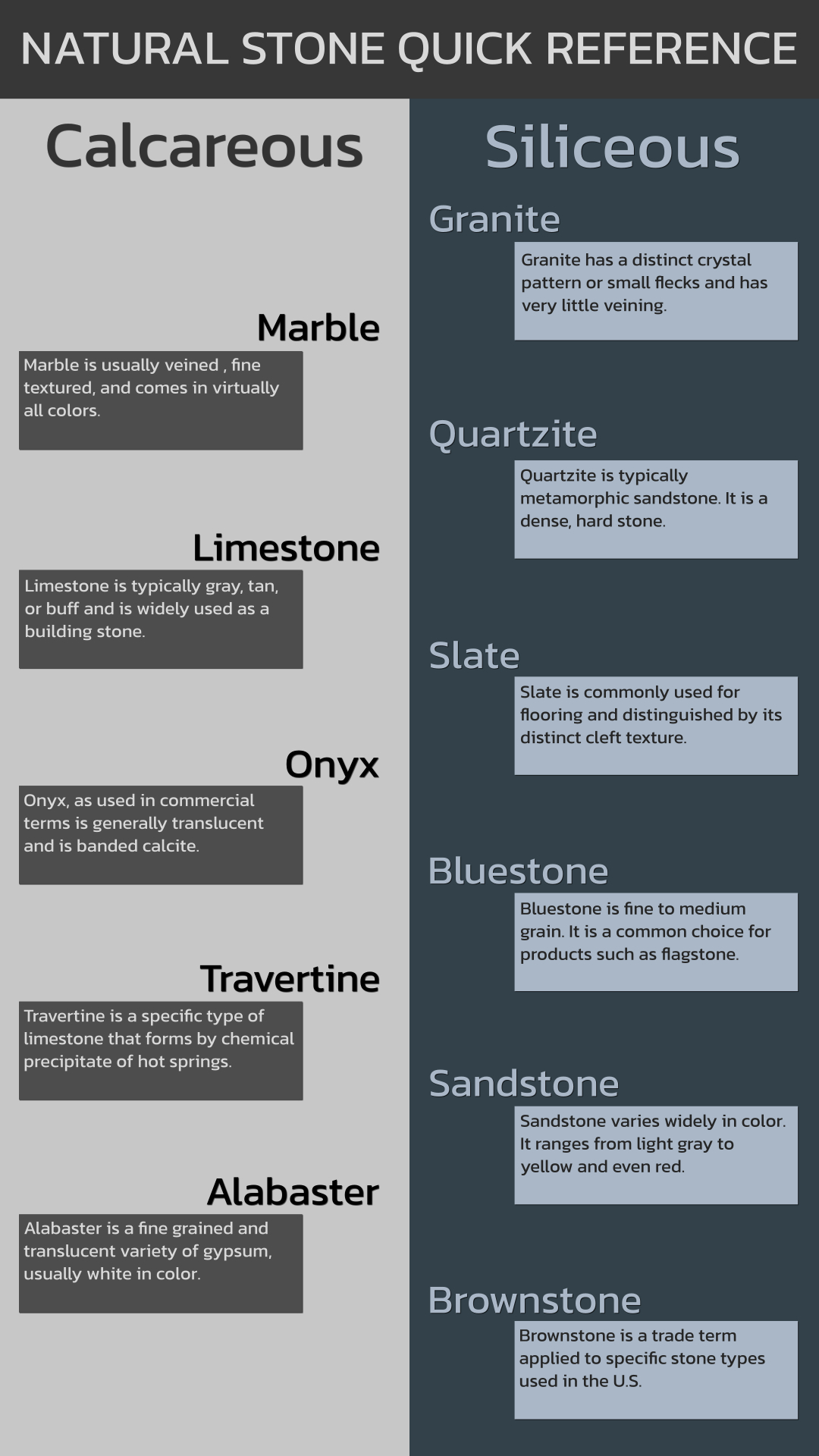2 Basic Natural Stone Types You Should Know
In the world of natural stone, there are a number of materials that are used for a wide variety of applications. Additionally, there are multiple labels used for various materials. In this article we are going to break natural stone materials into two primary groups. We will also describe what makes a stone fall into one group or the other. Finally, we will offer a quick reference for these two stone types. So let's get into discussing the 2 basic natural stone types you should know.
Siliceous Natural Stone
The first of the two types of stone that we will mention is siliceous stone. This type of stone is composed mainly of quartz-like particles and has a tendency to be very durable. Additionally, siliceous stone is generally easy to clean with mild acidic cleaners; relatively speaking. Several popular kinds of siliceous stone are used in the industry. Here is a list, although non-exhaustive, of siliceous stones:
- Granite
- Brownstone
- Bluestone
- Slate
As mentioned above, natural stone that is siliceous is generally durable. The reason for this lies in the material's make-up. The properties of the mineral quartz contribute to the properties of siliceous stone. Let's briefly highlight a couple of these properties.
Siliceous Stone is Hard
Above, we mentioned that siliceous stone is made up of particles that are "quartz-like". One of the primary traits of quartz is that it is hard. This contributes to the durability because the harder a material is, the more difficult it is to scratch. And we need not spend a bunch time explaining how scratch resistance contributes to durability. The hardness of siliceous natural stone means the material must be worked using blades used for harder stone materials.
Density of Siliceous Stone
Another feature of stone that falls into the siliceous category is that it tends to be very dense. This property contributes to the porosity of the material. The more porous a stone or other material is, the more susceptible it is to staining via liquids. The stain-ability of a material, naturally contributes to how durable it is.
Calcareous Natural Stone
The second of the two types of stone that we are looking at is calcareous stone. This group of stone materials is made up primarily of calcium carbonate. This difference in the primary mineral of which these stones are made means they have a couple of differences in their properties.
Calcareous Stone is Workable
Because the primary mineral in calcareous stone is calcium carbonate, these materials are not as hard as the previously mentioned group. However, this makes them desirable materials for any professional preferring stone that is more easily sculpted than are their counterparts. And even though calcareous stone is generally not as hard as siliceous materials are, they are still rock. So, these materials have much to offer in the way of building stone. In fact many buildings incorporate calcareous stone into their design.
Reactivity of Calcareous Stone
Another trait that is possessed by calcareous stone is that it is "reactive". Calcium carbonate reacts with acid. So, cleaning materials in this category requires following very specific procedures and using products that are designed for cleaning calcareous stone. Additionally, calcareous stone that has been in contact with an acidic liquid will likely etch. This is the term used to describe the visible evidence that a calcareous stone has had a reaction with acid. If a calcareous stone gets etched, you can treat the affected area using etch remover for calcareous stones such as:
- Marble
- Onyx
- Limestone
- Alabaster
When it comes to understanding how to work with and care for natural stone, much of the specifics will depend somewhat on which of the two groups discussed in this article. Because of this, we have put togehter a quick reference for natural stone. The following graphic not only lists the materials we have named in this article, but others as well. This can be a handy reference for you if you need to remember which type of stone a specific slab is so you may want to bookmark this page for future reference.
Natural Stone Reference
Below is an image listing each of the two categories of stone discussed in this article. Each category offers a list of materials that fall into the category and briefly describes the material.

|